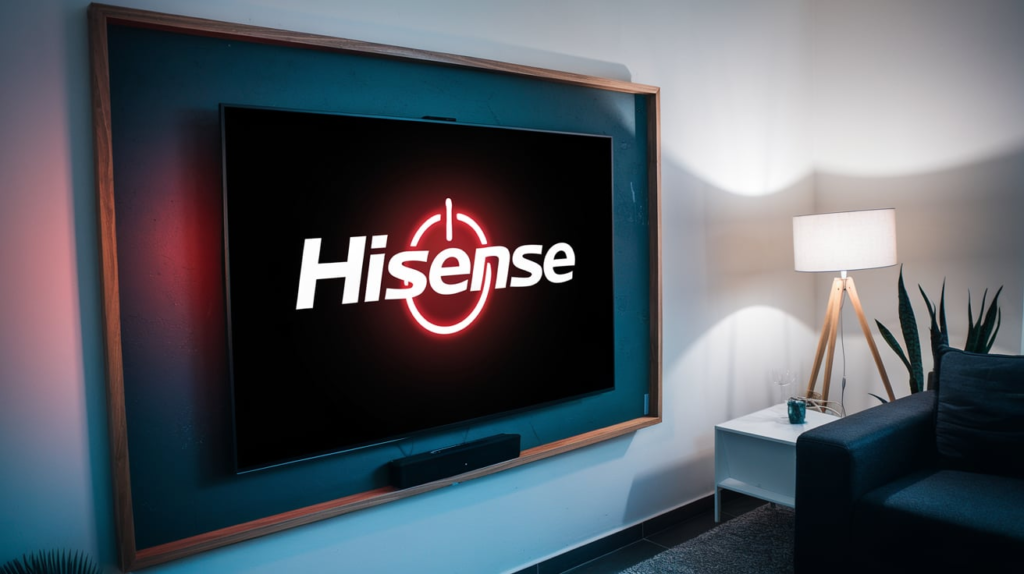If your Hisense TV is showing a blinking red light that flashes two, three, or even five times, it often means there’s an issue with either the power board, inverter, mainboard, or backlight. This behavior typically prevents the TV from turning on. Sometimes, a firmware glitch is responsible for this, and a simple resetting of the TV may resolve the issue. The pattern of the blinking—whether it’s two, three, or five blinks—helps in identifying the type of problem you’re dealing with.
Understanding blinking codes can help you understand what’s wrong faster. These codes give you an idea of the exact problem, allowing for a more focused solution. No matter the number of blinks, there are simple, instant fixes you can try to overcome the issue. By taking action quickly, you’ll be able to fix your Hisense TV without waiting for a costly repair.
Why Does Hisense TV Red Power Light Blink?
When you see a red power light blink on your Hisense TV, it’s usually a sign of an underlying issue. This could be related to either hardware or software problems. Here are the top reasons for this problem:
- Power supply issues are a common cause. If the power supply is damaged or interrupted, the TV won’t turn on properly.
- Main board or power board problems can also cause the red light blink. These components are vital for powering the TV, and faults in them can stop the TV from starting.
- Another cause could be backlight or inverter issues. If these parts are damaged or malfunctioning, they can prevent the TV from powering on.
- If there’s a faulty HDMI connection, it can also cause the red light blink. HDMI problems may disrupt the signal or power flow to the TV.
- Software glitches or bugs in the firmware could lead to unexpected issues, causing the red light to blink repeatedly.
- Interrupted power supplies or unstable electricity flow to the TV can lead to this issue, especially if there’s a damaged cable or socket.
- Sometimes, issues with the inverter or backlight prevent the TV from displaying anything on the screen, but it still causes the red light to blink.
- Finally, if there are recent changes to your TV’s firmware, it may lead to software glitches that affect its normal function, resulting in the red light blinking.
Read Also: Elevate Your Gaming Experience with Simple Tips
Restart Your TV
If you’re dealing with a Hisense TV that won’t turn on due to a flashing red light, one of the easiest solutions is to restart your TV. This often helps clear up software glitches or bugs that could be causing the issue.
- Turn off your TV by pressing the power button physically on the TV panel.
- Next, unplug the TV from the main power source. This helps reset the internal system.
- Wait for about 60 seconds before plugging the TV back in.
- Finally, replug the TV, and power it back on.
This simple process can often fix minor issues without needing to dive into more complicated troubleshooting.
Soft Reset Your TV
If a restart doesn’t work and the red light flashing issue persists, you can try power cycling or soft resetting your Hisense TV. Here’s a step-by-step guide to resolve it:
- Remove all connected devices from the Hisense TV to ensure no external device is causing the problem.
- Turn off the TV using the power button on the TV.
- Unplug the TV from the main power source to cut off power completely.
- Press and hold the power button for 30 seconds to drain any residual power.
- Wait for 30 minutes before proceeding to the next step.
- After waiting, plug back the TV into the socket.
- Plug in the TV and power on the TV to check if the flashing red light has stopped.
- If the issue is resolved, the red light flashing problem should no longer appear.
This simple yet effective method of soft resetting can often fix minor glitches in your TV’s system.
Factory Reset Hisense Smart TV
If your Hisense TV is still not turning on, a factory reset might help fix the problem. This option is useful when other troubleshooting steps haven’t worked. You can perform a hard reset without a remote, but keep in mind that it will delete all your personalized data and return the TV to its out-of-the-box state. To do this, carefully follow the instructions for a manual reset, and your Hisense smart TV could be back in working condition.
A factory reset is especially helpful when the issue is related to software or settings, and when you can’t get your TV to turn on properly. It’s important to note that this process can be time-consuming, so make sure to follow the steps carefully to avoid losing any important data.
Check The Power Outlet
As mentioned earlier, a red light blinking on your Hisense TV often points to power issues. If the problem persists even after resetting the TV, it’s time to inspect the hardware components of the TV. One key step in this process is to check the power outlet. Ensuring that the outlet is functioning properly can help eliminate power-related issues and might solve the blinking red light problem.
Check The Motherboard
A power surge can often damage or even burn the internal parts of your Hisense TV, such as the motherboard or power board. If this happens, you might need to fix or replace these components. However, this can be tricky and requires an understanding of electronics. If you’re not familiar with repairing electronics, it’s best to contact Hisense customer service and ask them to send a professional technician to resolve the problem.
In many cases, attempting to repair the motherboard yourself could lead to further damage, so seeking professional help is highly recommended. The technician will be able to diagnose the issue more efficiently and ensure your Hisense TV is back in working condition.
Conclusion:
Dealing with a Hisense TV flashing red light can be frustrating, but there are several ways to troubleshoot and fix the issue. The blinking pattern (two, three, or five blinks) often provides insight into the underlying problem, whether it’s related to the power supply, mainboard, backlight, or even software glitches. Simple actions like restarting the TV, performing a soft reset, or even a factory reset can often solve the problem without professional help. Additionally, checking the power outlet and motherboard can help identify any hardware issues that might be causing the red light.
If these steps don’t resolve the issue, contacting Hisense customer service or making use of your warranty can be the best course of action. Rather than attempting to repair the internal components yourself, which can void the warranty, it’s better to have a technician diagnose and fix the problem. With these straightforward solutions, you can get your Hisense TV back to normal without the need for costly repairs.
FAQ’s:
What does the flashing red light on my Hisense TV mean?
The flashing red light typically indicates an issue with the power supply, mainboard, inverter, or backlight. It could also be caused by a software glitch or firmware bug.
How do I restart my Hisense TV when the red light is flashing?
To restart your TV, simply turn it off using the power button, unplug it from the power source, wait for 60 seconds, and then plug it back in and turn it on.
What is a soft reset for a Hisense TV?
A soft reset involves unplugging the TV, holding down the power button for 30 seconds, waiting for 30 minutes, and then plugging the TV back in. This can help clear software glitches.
Can a factory reset fix the flashing red light on my Hisense TV?
Yes, if other methods don’t work, performing a factory reset can restore the TV to its original settings and may resolve the flashing red light issue, especially if it’s caused by a software or settings issue.
Will open my Hisense TV void the warranty?
Yes, attempting to repair or open the TV can void the warranty. If your TV is under warranty, it’s best to contact Hisense and let their professionals handle the repairs.



